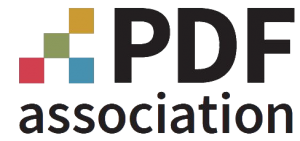ISO 21812-1
Print product metadata for PDF files – Part 1: Architecture and core requirements for metadata
The document part metadata in a PDF file that conforms to this document can be used to communicate the intended appearance of print products and their components. Examples of intended use are: direct interpretation within a production process, creation of job tickets such as XJDF, or populating records in an MIS. This document builds on the DPart syntax as specified in ISO 16612-2 (PDF/VT) and ISO 32000-2 (PDF 2.0) which is designed for encoding metadata related to pages or groups of pages in PDF files.
NOTE The document part metadata provided in this document applies to individual document parts, whereas XMP metadata typically applies to the scope of the entire document. XMP can apply to the scope of an individual page or part of a page but this usage is very uncommon. Thus, XMP is not applicable for the case where metadata is required for sets of pages such as multiple recipients or binding information. For example, XMP is used within PDF/X for file conformance identification and is also used for additional file level information such as author.
This document defines standardized metadata to:
- provide product intent specifications such as paper media selection and binding information;
- identify the type of product that the content pages are intended to represent (e.g. a brochure, letter or postcard);
- identify the intended recipient of each of the content pages for variable document printing applications.
This document defines a base conformance level that includes the syntax of the metadata framework and the semantics of a core set of metadata.
PDF files represent content pages and do not normally contain information identifying the usage of these content pages in print production. Document part metadata (DPM) is a simple mechanism that allows for the exchange of information regarding a set of content pages to aid the receiver of the PDF files in determining the intended use of those content pages in the final print product. By understanding the intended use of content pages, the receiver of the PDF file can make more informed decisions regarding the production process for the final print product. The structure of the metadata is intended to encapsulate sufficient information in a PDF file to guide the production of printed products without the creator needing to know the details of the production processes that will be used.
ISO 21812 accomplishes this through standardizing the DPM metadata that can be provided by a document creator. This document uses the DPart syntax as defined in PDF/VT and ISO 32000-2 (PDF 2.0). It has a close relationship with CIP4 XJDF Release 2.0.
For more information, refer to the PDF Association’s Technical Resources.
Comments?

Print workflow and metadata standards are used to communicate the intended appearance, processing steps, or job tickets for printed products through the use of existing PDF features.
Subscribe here for the PDF Association’s periodic updates regarding new, updated, or corrected industry and ISO specifications for PDF technology.
![]()
![]()
Community: please ask us!
ISO Group Responsible: ISO TC130 WG2
ISO Status: status of all PDF-related ISO work



